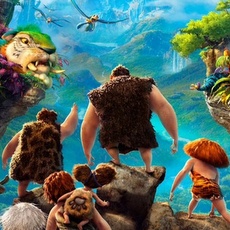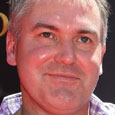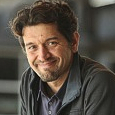 With the Academy Awards just around the corner, Animated News & Views’ Josh Armstrong had the pleasure of speaking with Chris Renaud, writer and co-director of the Oscar-nominated and Annie Award-winning No Time For Nuts.
With the Academy Awards just around the corner, Animated News & Views’ Josh Armstrong had the pleasure of speaking with Chris Renaud, writer and co-director of the Oscar-nominated and Annie Award-winning No Time For Nuts.
During the conversation, Renaud reminisced on his beginnings in animation, as well as how he joined Blue Sky Studios. Likewise, the director elaborated on the conception and reception of Nuts, starring the lovable saber-toothed squirrel Scrat from the Ice Age franchise.
Animated Views: When did you decide that you wanted a career in animation?
Chris Renaud: Not until somewhat recently, believe it or not. I originally wanted to get into comic books, drawing superheroes – Batman, Superman, all that stuff. When I graduated college in 1989, I wanted to be a comic book illustrator. So, I moved to New York, to try to do that. Took me quite a few years – about 4 or 5, I guess – to finally get some work with the big companies. (Marvel and DC was what I was trying for.) My first assignment was Legion of Super-Heroes with DC Comics, which, I want to say, was in ’94 or ’93 – I can’t remember exactly.
 I worked in comics for about five years. I had my own title with Marvel called Starfleet Academy for about 19 issues. I was the penciller. I was able to do some writing and some concept development with the character Batman. I had pitched an idea about an earthquake hitting Gotham City, which became a huge crossover and gave me the opportunity to do a little bit of writing within that arc, for a handful of stories.
I worked in comics for about five years. I had my own title with Marvel called Starfleet Academy for about 19 issues. I was the penciller. I was able to do some writing and some concept development with the character Batman. I had pitched an idea about an earthquake hitting Gotham City, which became a huge crossover and gave me the opportunity to do a little bit of writing within that arc, for a handful of stories.
But at the time, comic books as an industry were sort of going through, what I’ll call, a ‘transition.’ Marvel was in bankruptcy. A lot of the titles were dropping in sales. I was, at best, a mid-level talent. I wasn’t a star in the industry.
I started thinking about what were potentially some other options. I interviewed with a guy doing a show called The Book of Pooh, which was for the Disney Channel. It featured live-action puppetry with virtual sets. I didn’t get the job in the initial interview. But I was called about a year later, to come and try out to be the illustrator for the show – to create the texture maps, essentially. That was about in the year 2000.
I got the job and eventually became the production designer for that show, doing the sets and the texture maps. So, I guess that was kind of my introduction to animation. But the characters were puppetry-driven. I was really doing the sets, so I wasn’t involved in animation, specifically.
From that show, I went and did a couple more of these sort of puppet/CG-fusion projects. I designed a show called It’s a Big Big World, which is still on PBS. That gave me an opportunity to do characters as well as sets.
Then, about three years ago, I was hired by Blue Sky. I had sent them my portfolio to be reviewed as a story artist, but I didn’t really understand the position. I mean, I had seen behind-the-scenes things with Pixar. But I had done a lot of storyboards for commercials, which are very different – you’re really just sort of depicting camera angles for the director.
 When I got here, I sort of assumed it was a similar thing. Of course, I was very excited to find out that it was a lot more than that – that the directors were very collaborative and were looking for ideas. They were looking for a lot more than just camera angles, including comedy and gags and all sorts of input, which was great! I was so excited when I got here and really started investigating and learning what the job was about and making animated feature films. So, I’ve always had an interest in animation. But as far as working in it, really specifically, it’s only been about the last three years.
When I got here, I sort of assumed it was a similar thing. Of course, I was very excited to find out that it was a lot more than that – that the directors were very collaborative and were looking for ideas. They were looking for a lot more than just camera angles, including comedy and gags and all sorts of input, which was great! I was so excited when I got here and really started investigating and learning what the job was about and making animated feature films. So, I’ve always had an interest in animation. But as far as working in it, really specifically, it’s only been about the last three years.
AV: Did you attend any schools to study animation?
CR: I went to Syracuse University and studied illustration. So, I never studied animation specifically. Of course, I studied it in the sense that I have a great deal of respect and love for animation as a form. I’m the kind of guy that I have a three-year-old and a one-year-old, and didn’t have to buy any new movies when they were born. I had them all already. [laughs] I owned the Disney and the Pixar stuff. So, certainly, I always had an appreciation for it.
AV: Out of all the jobs you’ve been involved with – character and production designing, storyboard crafting, writing and directing – which would you say you’ve enjoyed doing most?
 CR: I think it’s hard to top writing and directing in the sense that, even with an established character like Scrat, you feel like you have the most input. Obviously, when Mike Thurmeier, the co-director, came on board, he took it to the next level. His input shaped the short and evolved it in a huge way.
CR: I think it’s hard to top writing and directing in the sense that, even with an established character like Scrat, you feel like you have the most input. Obviously, when Mike Thurmeier, the co-director, came on board, he took it to the next level. His input shaped the short and evolved it in a huge way.
But I think that the writing, developing – the concept development – to me, is the most exciting part, because I think everything flows from that. From my perspective, I try to consider every aspect when I go into concept development. So, I think of it from a design point of view. That’s part of my television background.
In fact, this concept – even though it has a lot in it – when I initially pitched it, I really was trying to think of a way it could actually be achieved from a production point of view. I knew that if I went in there and said, ‘Oh, we’re going to be in The Sword in the Stone, and there’s going to be a hundred knights that swarm him,’ it just would never happen. Production would be like, ‘Get out of here.’
So, I think that concept development involves all of those things. To me, personally, it does, including production needs. It’s great to come up with an idea, but if you can’t actually make it, it’s kind of pointless.
AV: You mentioned your co-director, Mike Thurmeier. When did he come aboard the project?
CR: I had done an initial pitch – very rough. From there, I started fleshing out the boards. I had fleshed out the boards to the point where they were going to go to editorial, to be in the first pass in creating the story reel. That’s when Mike came on board, as we were going into our first story reel creation. Most of the basic ideas were there, in that board pass. However, it changed quite a lot as we shaped it, moving through the whole process.
AV: When did the idea for No Time For Nuts first arrive?
CR: Well, Blue Sky, Carlos Saldanha and Lori Forte – the director and producer of Ice Age: The Meltdown – came to the story team and said, ‘We’re looking for ideas for a short to include on the DVD.’ Carlos obviously had a rich heritage with this, because he had directed the Scrat short Gone Nutty, which appeared on the original Ice Age DVD. While they didn’t limit it to Scrat, everyone kind of felt that was what they were looking for. I think somebody did do a Crash and Eddie the possums idea. Anyway, they came to us and said, ‘We want to see ideas for the DVD short, and everyone can present two.’ So, the story artists – I think most of us presented two, and I think one of the writers actually presented a couple of ideas.
Lori and Carlos selected mine, which at the time was called Time For Nuts. We added the No later. That’s sort of how it started.
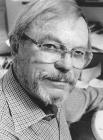 In my own thinking, it started with, ‘What can you do with Scrat that maintains his essence but is unexpected?’ I definitely was thinking of the way that Chuck Jones would approach the Looney Tunes characters, and also even The Simpsons – they do a set-up in the first two minutes, and then they’ll spend the rest of the episode in Africa or something. [laughs]
In my own thinking, it started with, ‘What can you do with Scrat that maintains his essence but is unexpected?’ I definitely was thinking of the way that Chuck Jones would approach the Looney Tunes characters, and also even The Simpsons – they do a set-up in the first two minutes, and then they’ll spend the rest of the episode in Africa or something. [laughs]
Specifically, Robin Hood Daffy – obviously, Daffy Duck originally was just a duck in a pond, that was being hunted by Porky Pig, I think. To get all the way to the point where you’re like, ‘Well, you know what, let’s make him Robin Hood’ – Scrat has more rules than that. But those were the kinds of things that I was thinking of. The time machine seemed like the perfect plot device to get some of those ideas going.
AV: How long did it take to create No Time For Nuts?
 CR: I think it was about eight months, roughly. A lot of people were working on-and-off and in-between projects, because we were rolling off of Ice Age: The Meltdown and onto Horton Hears a Who, myself and Mike included. So, it wasn’t eight months solid, but it was across eight months.
CR: I think it was about eight months, roughly. A lot of people were working on-and-off and in-between projects, because we were rolling off of Ice Age: The Meltdown and onto Horton Hears a Who, myself and Mike included. So, it wasn’t eight months solid, but it was across eight months.
AV: What would you say was the biggest challenge you faced in writing and co-directing the short?
CR: To me – and I think Mike would agree with this – the biggest trick is pacing, honestly. I think that’s kind of the language of film. We had a lot of ideas that we wanted to get in there, and a lot of gags. Just to get them all timed so we felt they were working, and also so a fresh audience could understand them – sort of balancing the break-neck pace with the clarity – I think that was the biggest challenge we both faced in putting this together.
AV: Were there any concepts or scenes deleted from No Time For Nuts?
CR: There were concepts deleted at the end, where we’re rolling through all that fast stuff. There was one where Scrat was in the Old West, and he’s dodging bullets very quickly. We had a ton of different ideas. I mean, we definitely whittled it down to the best ones. He was in a bank vault, but of course, that became the jewelry store or the museum display – whatever that is. [laughs]
We had a couple ideas that were like natural disaster-type things. There was a tornado, and there was the asteroid that killed the dinosaurs. But in the end, we wanted to stick with our theme of ‘Scrat versus humanity.’ So, anything like that – well, some of them were funny; they just didn’t quite work within the theme of what we were going for. So, those were eliminated.
Beyond that, there were a couple of shots, specifically in the Sword and the Stone segment, that we cut that actually went as far as animation. But that was really it. It was very close to what our story reel was, as far as moving forward into production.
AV: Are there any inside jokes or references that folks should look for, in No Time For Nuts?
CR: The only one I can think of is on the locomotive. It’s not even that funny, but it’s just a note. When the locomotive is coming up to Scrat, there’s a golden spike in the railroad track, and that’s the meeting of the Transcontinental Railroad. I don’t know if you remember that from the history book. [laughs] So, we actually put the golden spike there, which you have to look very hard for.
Now there is one more joke. In the time tunnel, the hourglass that tumbles by is filled with acorns versus sand. So, you have to keep watch for that. The acorns – the tech guys did a great job. They sort of attached the model of the acorn to the fluid dynamics, which would normally be sand. So they put a nut on that, and it looks pretty cool.
AV: Looking back on the short, is there anything you wish you could change?
CR: You know, not much. I think that there may have been a couple of ideas that, as I’ve watched it with a fresh audience – somebody who wasn’t sitting with it over and over – that maybe we could have made a little clearer. Things like the time tunnel, because when you’re a fresh audience watching it, you’re like, ‘Where am I?’
 But it’s hard to say. I think, overall, both Mike and myself, at the end of the day, felt pretty good and felt that it ended up actually better than we probably hoped when starting. Like I said, if anything, maybe some clarity issues. But those are very hard to anticipate, because you’re sitting with it, and your mind is filling in the blanks. You’re like, ‘Oh, I know I’m in a time tunnel.’ But it was an interesting experience on that level, because sometimes a fresh audience – they haven’t been sitting with you, having to watch it for hour upon hour. [laughs] But overall, no, I think we were pretty pleased with the way it ended up.
But it’s hard to say. I think, overall, both Mike and myself, at the end of the day, felt pretty good and felt that it ended up actually better than we probably hoped when starting. Like I said, if anything, maybe some clarity issues. But those are very hard to anticipate, because you’re sitting with it, and your mind is filling in the blanks. You’re like, ‘Oh, I know I’m in a time tunnel.’ But it was an interesting experience on that level, because sometimes a fresh audience – they haven’t been sitting with you, having to watch it for hour upon hour. [laughs] But overall, no, I think we were pretty pleased with the way it ended up.
AV: As you said earlier, No Time For Nuts was created for the Ice Age: The Meltdown DVD. When was it decided to make the short eligible for Oscar consideration?
CR: I think kind of late, actually. We finished it in June. The producers, John Donkin and Lori Forte, really had a lot of faith in it and were always sort of moving it toward going to film. In order to be eligible, you’ve got to show it in a theater, so you have to go to film. You can’t just have a digital file. So, they were great in doing that.
I think once the piece was done, and people were all feeling good about it, it was decided to put it in for ’06. I can’t give you exact timing, but it was definitely sometime in the late summer, I would say, because we just made the window, I believe. It was very close, because I think you had to show it by the end of September. So, we got it in, just under the wire.
AV: How did you find out that No Time For Nuts had been Oscar-nominated for Best Animated Short?
CR: John Donkin, the producer, called me. He had heard from Ron Diamond at AWN. It was funny, because my wife and parents were watching the telecast. Animated Short isn’t on that. So, Salma Hayek walks off the stage, and my parents and wife were calling, ‘What happened?! When’s the announcement?!’ From there, it was about 20 minutes until I heard. Anyway, that’s how I heard – the producer called me.
AV: Were you shocked, or was the nomination somewhat expected?
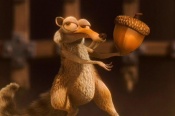 CR: Not expected at all. I’ll call it a pleasant surprise, to say the least. We knew we were on the short list. When the short list was first published, I was like, ‘Wow! I don’t think we’ve got a shot, because there are a lot of very strong films on there.’ Several of them had won awards. One had taken the top prize at Annecy. One had the top prize at Ottawa; another, the top prize at Siggraph.
CR: Not expected at all. I’ll call it a pleasant surprise, to say the least. We knew we were on the short list. When the short list was first published, I was like, ‘Wow! I don’t think we’ve got a shot, because there are a lot of very strong films on there.’ Several of them had won awards. One had taken the top prize at Annecy. One had the top prize at Ottawa; another, the top prize at Siggraph.
I mean, you’ve always got a shot. You always hope. But it was a nice surprise to hear we were nominated.
AV: What advice would you like to offer anyone wanting to work in the animation industry?
CR: I can only sort of give my perspective on it. I think that having an eclectic background can be advantageous. Look for inspiration in places beyond animation itself and see what’s going on. Look at how the tool sets are changing. Look to live-action films; look to literature; look to comic books. Look to all kinds of things to decide what kind of stories you want to tell and how you want to tell them.
I think the tool sets are becoming transparent and can get into the hands of a lot of different people. What you can lend to them is your perspective. That’s what will make something stand out.
Special thanks to Chris Renaud for participating in the interview. Also, thanks to Michelle Doshna for arranging the conversation. Furthermore, thanks to her and Stephanie Swengel for providing photos of the Blue Sky Studios staff.



